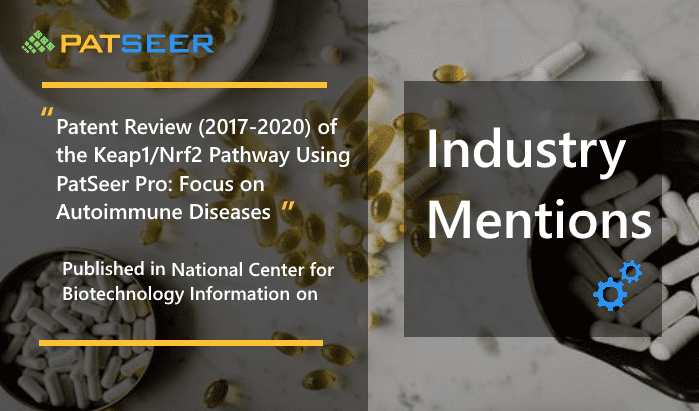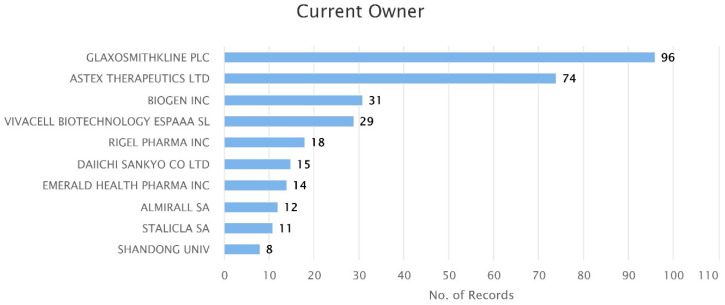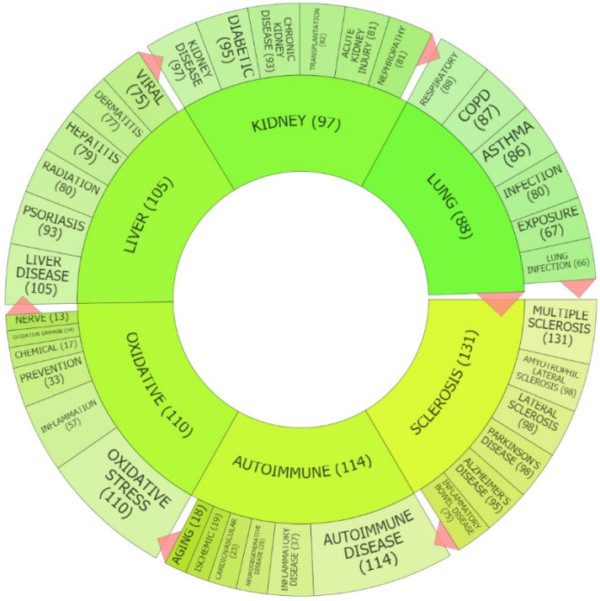Share
Share
Patent Review (2017-2020) of the Keap1/Nrf2 Pathway Using PatSeer Pro: Focus on Autoimmune Diseases
Introduction
Nuclear factor erythroid 2-related factor 2 (Nrf2, encoded by Nfe2l2/NFE2L2) is a transcription factor that coordinates the cellular responses to oxidative, electrophilic, and nitrosative stresses. Kelch-like ECH-associated protein 1 (Keap1) is a cysteine-rich protein that facilitates the rapid proteasomal degradation of Nrf2 under basal conditions. Upon exposure to reactive oxygen species, other stressors, or various natural and synthetic Nrf2-activating compounds, the sulfhydryl groups of Keap1 cysteines are modified, leading to allosteric modification of Keap1 that renders it unable to target Nrf2 for degradation. Thus, de novo transcribed and translated Nrf2 accumulates in the cell and enters the nucleus, where it recognizes specific sequences called antioxidant response elements (AREs) in the regulating regions of its target genes

Abstract
Research on the antioxidant pathway comprising the transcription factor nuclear factor erythroid 2-related factor 2 (Nrf2) and its cytoplasmic inhibitor Kelch-like ECH-associated protein 1 (Keap1) is ever increasing. As modulators of this pathway have started to be used in clinical trials and clinical practice, Nrf2 has become the subject of several patents. To assess the patent landscape of the last three years on Nrf2 and evaluate the main fields they refer to, we used the web-based tool PatSeer Pro to identify patents mentioning the Nrf2 pathway between January 2017 and May 2020
This search resulted in 509 unique patents that focus on topics such as autoimmune, neurodegenerative, liver, kidney, and lung diseases and refer to modulators (mainly activators) of the Nrf2 pathway as potential treatments. Autoimmunity emerged as the main theme among the topics of Nrf2 patents, including a broad range of diseases, such as systemic sclerosis, systemic lupus erythematosus, multiple sclerosis, inflammatory bowel diseases, Hashimoto’s thyroiditis, etc.
Current Owner

The above charts shows Notably, 9 out of 10 of the top current owners of Nrf2 patents are pharmaceutical companies , indicating that there is both research and commercial interest in Nrf2 pathway modulators.
Topics Chart

The above charts shows the most enriched topics in the published patents on Keap1/Nrf2 are highlighted in below image. It is evident that most patents include references to “sclerosis” (131 instances), “autoimmune” diseases (114 instances), “oxidative” stress (110 instances), “liver” (105 instances), “kidney” (97 instances), and “lung” (88 instances). Patents associated with “sclerosis” mainly refer to neurodegenerative diseases, such as MS, amyotrophic lateral sclerosis, Parkinson’s disease, and Alzheimer’s disease, but also to inflammatory bowel disease (IBD, encompassing Crohn’s disease and ulcerative colitis). The “autoimmune” topic is broader and encompasses patents relevant to a variety of autoimmune and inflammatory diseases, including neurodegenerative, cardiovascular, and aging-related diseases. The “oxidative” stress topic is also very broad and includes Keap1/Nrf2-related patents on anything relevant to reactive oxygen species and inflammation.
To read the complete report visit – Patent Review (2017–2020) of the Keap1/Nrf2 Pathway Using PatSeer Pro: Focus on Autoimmune Diseases
Publishing Date: Nov 2020
Language: English
Research Paper link: https://www.ncbi.nlm.nih.gov/pmc/articles/PMC7697445/
The patent search and analysis mentioned under this research paper is created using PatSeer.
Author:
Dionysios V. Chartoumpekis, Service of Endocrinology and Diabetology, Lausanne University Hospital, and Faculty of Biology and Medicine
Chun-Yan Fu,Department of Pathology and Pathophysiology, Zhejiang University School of Medicine
Panos G. Ziros, Service of Endocrinology and Diabetology, Lausanne University Hospital, and Faculty of Biology and Medicine
Gerasimos P. Sykiotis, Service of Endocrinology and Diabetology, Lausanne University Hospital, and Faculty of Biology and Medicine




